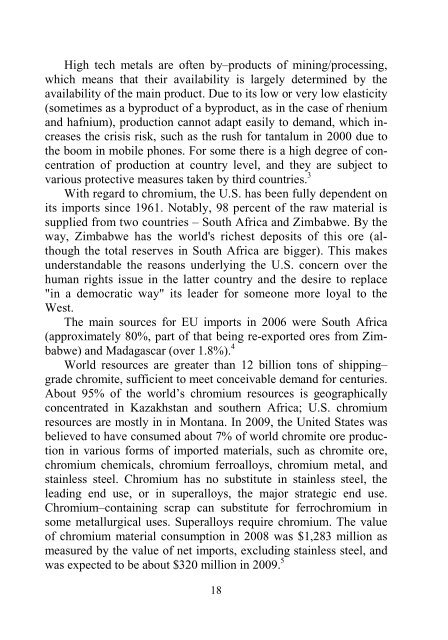L. Fituni, I. Abramova Resource Potential of Africa and Russia's ...
L. Fituni, I. Abramova Resource Potential of Africa and Russia's ...
L. Fituni, I. Abramova Resource Potential of Africa and Russia's ...
Create successful ePaper yourself
Turn your PDF publications into a flip-book with our unique Google optimized e-Paper software.
High tech metals are <strong>of</strong>ten by–products <strong>of</strong> mining/processing,<br />
which means that their availability is largely determined by the<br />
availability <strong>of</strong> the main product. Due to its low or very low elasticity<br />
(sometimes as a byproduct <strong>of</strong> a byproduct, as in the case <strong>of</strong> rhenium<br />
<strong>and</strong> hafnium), production cannot adapt easily to dem<strong>and</strong>, which increases<br />
the crisis risk, such as the rush for tantalum in 2000 due to<br />
the boom in mobile phones. For some there is a high degree <strong>of</strong> concentration<br />
<strong>of</strong> production at country level, <strong>and</strong> they are subject to<br />
various protective measures taken by third countries. 3<br />
With regard to chromium, the U.S. has been fully dependent on<br />
its imports since 1961. Notably, 98 percent <strong>of</strong> the raw material is<br />
supplied from two countries – South <strong>Africa</strong> <strong>and</strong> Zimbabwe. By the<br />
way, Zimbabwe has the world's richest deposits <strong>of</strong> this ore (although<br />
the total reserves in South <strong>Africa</strong> are bigger). This makes<br />
underst<strong>and</strong>able the reasons underlying the U.S. concern over the<br />
human rights issue in the latter country <strong>and</strong> the desire to replace<br />
"in a democratic way" its leader for someone more loyal to the<br />
West.<br />
The main sources for EU imports in 2006 were South <strong>Africa</strong><br />
(approximately 80%, part <strong>of</strong> that being re-exported ores from Zimbabwe)<br />
<strong>and</strong> Madagascar (over 1.8%). 4<br />
World resources are greater than 12 billion tons <strong>of</strong> shipping–<br />
grade chromite, sufficient to meet conceivable dem<strong>and</strong> for centuries.<br />
About 95% <strong>of</strong> the world’s chromium resources is geographically<br />
concentrated in Kazakhstan <strong>and</strong> southern <strong>Africa</strong>; U.S. chromium<br />
resources are mostly in in Montana. In 2009, the United States was<br />
believed to have consumed about 7% <strong>of</strong> world chromite ore production<br />
in various forms <strong>of</strong> imported materials, such as chromite ore,<br />
chromium chemicals, chromium ferroalloys, chromium metal, <strong>and</strong><br />
stainless steel. Chromium has no substitute in stainless steel, the<br />
leading end use, or in superalloys, the major strategic end use.<br />
Chromium–containing scrap can substitute for ferrochromium in<br />
some metallurgical uses. Superalloys require chromium. The value<br />
<strong>of</strong> chromium material consumption in 2008 was $1,283 million as<br />
measured by the value <strong>of</strong> net imports, excluding stainless steel, <strong>and</strong><br />
was expected to be about $320 million in 2009. 5<br />
18







